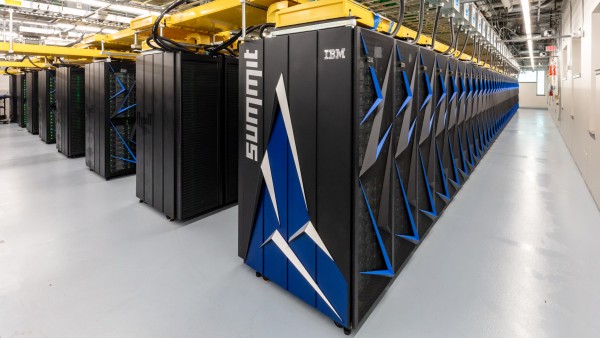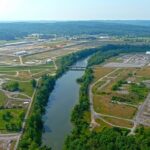
Note: This story was last updated at 3 p.m. June 24.
A Japanese supercomputer has displaced the Summit supercomputer at Oak Ridge National Laboratory as the world’s most powerful and bumped other U.S. and Chinese machines down one spot on a semiannual list of the fastest systems.
Summit had been ranked the world’s most powerful supercomputer on the semiannual TOP500 list since June 2018. It was bumped to number two when the new TOP500 list was released Monday.
The new top system is installed in Kobe, Japan, and it is named Fugaku. In a high-performance test, it performed at 415.5 petaflops. A petaflop is a quadrillion floating-point operations per second.
Fugaku’s performance was 2.8 times better than Summit’s, according to TOP500. Summit delivered 148.8 petaflops on the high-performance test.
Like Summit, Fugaku, another name for Mount Fuji, is being used for research about COVID-19, among other tasks.
Summit remains the fastest supercomputer in the United States. ORNL is already working on a new more powerful machine, an exaflop system named Frontier, that is expected to be the world’s fastest when it debuts in 2021.
The shuffling at the top of the new list on Monday is a change from the past eight years, when either the United States or China had the most powerful supercomputer. Supercomputers are room-sized systems that can cost hundreds of millions of dollars, and they can be used for scientific research and for work on nuclear weapons.
Fugaku bumped four supercomputers in the United States and China down one spot each on the TOP500 list. Summit at ORNL and Sierra at Lawrence Livermore National Laboratory in California are now number two and number three on the list. Two supercomputers in China are now number four and number five: Sunway TaihuLight and Tianhe-2A (Milky Way-2A).
Japan last had the top supercomputer, Fujitsu’s K Computer, in November 2011. It was the first to exceed 10 petaflops.
The new Japanese supercomputer, Fugaku, is powered by Fujitsu processors. It’s installed at the RIKEN Center for Computational Science in Kobe.
TOP500 said Fugaku’s peak performance is over 1,000 petaflops, or one exaflop, when using single or further reduced precision, which are often used in machine learning and artificial intelligence applications. Exaflops are a next frontier in supercomputing, after petaflops.
Before Monday, the United States had had the number one and number two systems in the world since November 2018.
After Summit, which is now number two, the number three machine is now Sierra at Lawrence Livermore National Laboratory. It achieved 94.6 petaflops on the TOP500 list.
Summit and Sierra are both IBM-built supercomputers that use Power9 central processing units (CPUs) and NVIDIA Tesla V100 graphics processing units (GPUs). Both use a Mellanox EDR InfiniBand network as the system interconnect. Summit at ORNL was announced as a 200-petaflop system, capable of 200,000 trillion calculations per second, in June 2018.
Summit and Sierra are part of the U.S. Department of Energy and National Nuclear Security Administration complex. Summit is a DOE Office of Science supercomputer, and Sierra is an NNSA supercomputer. The NNSA is a semi-independent agency within DOE that is responsible for maintaining the nation’s nuclear weapons stockpile, working on nuclear nonproliferation, and fueling naval nuclear reactors.

Summit is reported to be about eight times more powerful than Titan, its predecessor, which was once the world’s fastest and was retired in August. Officials celebrated the launch of Summit in a ceremony attended by former U.S. Energy Secretary Rick Perry on June 8, 2018.
Last year, ORNL officials said Titan was being disassembled and removed to install Frontier, a new supercomputer that is expected to be the world’s most powerful when it debuts at ORNL in 2021. Perry attended an announcement ceremony for that supercomputer in May 2019.
Frontier will be a $600 million Cray supercomputer that is expected to perform at greater than 1.5 exaflops. It will be able to solve calculations up to 50 times faster than today’s top supercomputers, exceeding a quintillion, or 1018, calculations per second. That’s a billion billion calculations per second.

The number four and number five supercomputers on Monday’s TOP500 list are both Chinese systems that were once the top machines. At number four is Sunway TaihuLight, a system developed by China’s National Research Center of Parallel Computer Engineering and Technology. It is powered by Sunway processors, and it performed at 93 petaflops. That’s unchanged since the system was installed at the National Supercomputing Center in Wuxi, China, in June 2016, TOP500 said. Sunway TaihuLight was the top machine at that time.
The number five machine is Tianhe-2A (Milky Way-2A), a system developed by China’s National University of Defense Technology. It achieved 61.4 petaflops. It uses Intel Xeon CPUs and custom-built coprocessors, and it is deployed at the National Supercomputer Center in Guangzhou, China. It was named number one in June 2013, when it bumped ORNL’s Titan from the top spot.

TOP500 said China continues to dominate with the most systems, 226 supercomputers on the list, while the United States is number two with 114. Japan is third with 30; France has 18; and Germany has 16.
The United States is first in performance with 644 petaflops compared to China’s 565 petaflops. Japan’s systems deliver 530 petaflops.
Here are the rest of the top 10 supercomputers announced Monday by TOP500:
- HPC5—35.5 petaflops. A new system installed by the Italian energy firm Eni S.p.A, it’s the fastest supercomputer in Europe. It’s a PowerEge system built by Dell, powered by Intel Xeon Gold processors and NVIDIA Tesla V100 GPUs. It uses Mellanox HDR InfiniBand as the system network.
- Selene—27.58 petaflops. A new system installed at NVIDIA in the United States, it is a DGX SuperPOD, powered by NVIDIA “Ampere” A100 GPUs and AMD EPYC “Rome” CPUs. It also uses Mellanox HDR InfiniBand as the system network.
- Frontera—23.5 petaflops. It is a Dell system with Intel Xeon cores installed at the Texas Advanced Computing Center.
- Marconi-100—21.6 petaflops. This Italian system is powered by IBM Power9 processors and NVIDIA V100 GPUs, and it is installed at the CINECA research center. It also uses a Mellanox EDR InfiniBand as the system network.
- Piz Daint—19.6 petaflops. This is a Cray system installed at the Swiss National Supercomputing Centre in Lugano, Switzerland. It is equipped with Intel Xeon processors and NVIDIA P100 GPUs.
See the TOP500 list here.





Leave a Reply